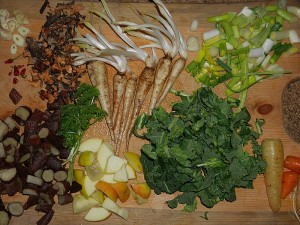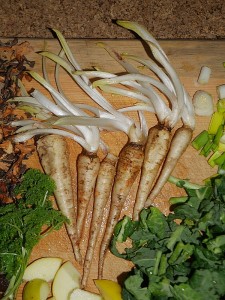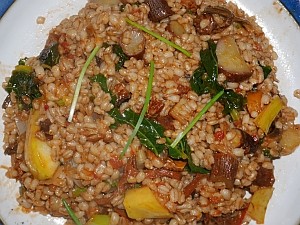Tonight’s mix of veg for a barlotto (Norw: byggotto) in which you can put what you want.



Tonight’s mix of veg for a barlotto (Norw: byggotto) in which you can put what you want.



From 2001, Bioforsk (the Norwegian Institute for Agricultural and Environmental Research, now NIBIO) department in Kise, Hedmark started collecting plant material of roseroot (Rhodiola rosea) from all over Norway. A field collection of some 97 clones resulted at Kise and analyses of the adaptogen components were reported by Steinar Dragland and Ruth Mordal in 2006. It was found that levels of the active chemicals was higher in the populations in Northern Norway than in the south and a selection was made called “Kise Mix” used to establish plants in different places around the country.
Ref: Dragland and Mordal, 2006. Variasjoner i rosenrot (Rhodiola rosea) fra 97 steder i Norge. Bioforsk Tema Nr. 47. (see http://www.bioforsk.no/ikbViewer/Content/26262/t_1_47_dragland.pdf)
I visited one of the growers Rigmor Solberg in Sortland, Northern Norway in 2009 (pictures below).
Sadly, the market collapsed due to cheap Russian imports and this field was never harvested.
I just came across the first picture below that I took of tiger nuts on sale in Japan on my visit in spring 2016…Super Food…there are 3 types: peeled, unpeeled and bio-peeled (whatever that means?)
The second picture is of a commercial packet I bought in a supermarket in Oregon, USA in September 2015.
One of the very very exciting moments of the year happened yesterday evening ![]() Thanks so much yet again to those amazing volunteer seed packers of the SRGC…and I’ll say it again this is a must for the perennial vegetable enthusiast….our numbers are increasing fast and there will soon be more of us than the ornamental enthusiasts
Thanks so much yet again to those amazing volunteer seed packers of the SRGC…and I’ll say it again this is a must for the perennial vegetable enthusiast….our numbers are increasing fast and there will soon be more of us than the ornamental enthusiasts ![]()
See http://www.srgc.net/site/index.php/extensions/seed-exchange
Having completed my course at Naturplanteskolen and guided walk at Grennessminde in August 2016, I was “rewarded” by being taken on a botanical excursion to the island Langeland. These pictures were taken at the north tip of the island which had a luxurious seaweed fertilised vegetation of some familiar perennial vegetables! Thanks to Aiah Noack of Naturplanteskolen :)
In my book, I wrote the following in my account about Sea Kale (Crambe maritima):
“Domestication of sea kale (in the UK) seems largely to have been due to the efforts of the botanist William Curtis, who was Praefectus Horti at the Chelsea Physic Garden in London in the 1770s. It is still grown there (see photo 7). He wrote a pamphlet, ‘Directions for the culture of the Crambe maritima or Sea Kale, for the use of the Table’ in 1799 to bolster his efforts in introducing it as a market vegetable”
I’ve now finally managed to get a copy of it thanks to a coincidental meeting with Sheila John of the Curtis museum in Alton, Hampshire who attended a talk I gave at the Sir Harold Hillier Gardens in May 2015 (see http://www.edimentals.com/blog/?page_id=1281). We kept in touch and I will actually be giving a talk at the Curtis Museum on 27th April! The museum kindly purchased a copy of the pamphlet on Sea Kale from the Natural History Museum in London and sent me the pdf copy which you can download below!
A great little historical docment, here are a few quotes which I found interesting:
“Brassica dobrica: kale found at Dover (Dover Cole)”
“…….in some grounds a troublesome weed” !
“Authors describe a variety with jagged leaves, such we have not seen….”
“As an article of food, Crambe maritima appears to be better known here than in any other part of Europe.
”..on many parts of the sea-coast, especially of Devonshire, Dorsetshire and Sussex, the inhabitants for time immemorial, have been in the practice of procuring it for their tables, preferring it to all other greens”
“The more curious, desirous of having it near at hand…..have now in many of the maritime counties introduced it to their gardens, and in Devonshire particularly, almost every gentleman has a plantation of it….we have been informed it has for many years been cultivated for sale in the neighbourhood of Bath”
“My friend Mr. Wm.Jones of Chelsea tells me he saw bundles of it in a cultivated state exposed for sale in Chichester market, in the year 1753”
Every morning a large flock of Jackdaws / kaie fly past the house on the way to farmland to the east where they feed during the day…it happens very quickly so difficult to film. This morning I was filming the view of a snow shower over the fjord and the flock arrived, so I quickly started filming…